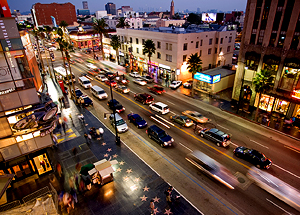RECOMMENDED
Homeless youth are given a voice—a singing voice—in Michael Leoni’s ambitious, sprawling “street rock musical” The Playground, now playing at Hollywood’s Met Theatre under the playwright’s direction.
Though The Playground could stand to lose as much as a third of its three-hour-long running time (thereby benefitting from the streamlined length and pacing of Leoni’s smash hit Elevator), the plight of its homeless protagonists and the power of the cast’s vocal performances make this patchwork quilt of a musical worth checking out.
L.A. audiences (and this reviewer) first met Leoni’s tribe of street kids in The Playground’s 2003 debut at the Complex—a considerably shorter, tighter production which featured a dozen well-known pop tunes and two original compositions by cast member Gunner Wright. A 2006 run at Deaf West Theatre replaced the twelve covers with two dozen songs by Beth Hart, Wright, and new cast member Sebastian Sage, some of them preexisting, others written for the production.
The Playground now returns to Hollywood minus the Sage compositions, their place taken by songs by Michael Montoya, cast addition Ishmael Herring, and Winston King, Jr.—a grand total of thirty-two musical numbers in all. Add to that a half dozen rap poems and considerable dialog and you have a musical that runs longer than all but the longest Broadway musicals.
A striking opening sequence on an extraordinarily detailed, trash strewn, graffiti scrawled street in a Los Angeles slum neighborhood introduces us to our cast of characters. There’s Hayden (a role originated by Leoni and now played by Keli Price), who has run away from an abusive home environment with best girlfriend Luka (Rachael Page) in tow. Pimp/songwriter Ash (Shawn Parsons) has a stable of male and female sex workers under his thumb, including wannabe songstress Star (Lexy Pantera) and sensitive rentboy Vegas (Leoni). HIV positive Mama (2006 cast member Erica Katzin) is about to give birth to a child fathered by her lover Drifter (Nick Teti). Gay teen Happy (Corbin Mayberry) has been on the street since getting caught in the same-sex act by his intolerant dad. Other street kids include Bear (Herring), Sunshine (Elwie Harris), Princess (Karly Rigbee), and Stoney (Ryan Nelson). Lindsey Gort plays well-to-do do-gooder Sam, with Deb Vancelette and Tyler Tanner appearing in a dozen or so wigs each as assorted parents, johns, and other adult characters. That virtually all of the street kids are strung out on drugs goes without saying.
With so many characters’ lives to follow, it can become tough to recall just who is who and what each character’s back story is, a feat made more challenging by the producers’ ill-advised decision not to distribute programs until after the performance. There are many reasons for audiences to have playbill in hand before and during a show, all of which ought to have overriden whatever prompted leaving us uniformed for three hours.
A too haphazard structure gets in the way of The Playground’s achieving the success Leoni’s high-intentioned concept deserves. If Jonathan Larson’s Rent can be compared to a painstakingly designed and refined urban building with a single architect, The Playground comes across more like an edifice that started small and got added onto by various builders at various times, with some rooms stuck on to the original and others replacing rooms that used to be there.
In addition, despite the large number of songs featured in The Playground, it takes twenty-minutes or so for the first full-length song to be performed, thereby breaking one of the basic rules of Musical Theater 101. By contrast, Act Two features one too-similar rock ballad after another, with little dialog in between. Rent offers a textbook example of how songs can serve to advance a musical’s plot. In contrast, the Playground’s hodgepodge of musical numbers serve mostly to reveal characters’ feelings at any given moment, those being primarily despair and anger, or a combination of both.
Fortunately, these are powerful songs which get performed by some powerful singers. Price makes for a stellar Hayden, bringing to the role the striking good looks and lean muscled physique that go with his Ford model résumé, vocal skills befitting this 2010 BMI Young Songwriter Of The Year, and acting chops to match. (If only Hayden were given a bit more than a three-day time span for his 180 degree transformation from clean-cut runaway teen to greasy, grubby, drug-addicted, hard-bitten hustler.) Big-voiced rock belters Katzin, Page, and Pantera provide vocals that are as good as it gets, though the latter two could benefit from more nuanced acting in their dialog sequences. Parsons is suitably sleazy/sexy, Leoni makes a strong impression as the probably gay-in-denial Vegas, and Gort, Harris, Herring, Mayberry, Nelson, Rigby, and Teti all do topnotch work in supporting roles. Tanner creates multiple diverse male characters, and Vancelette impresses in a series of intensely performed dramatic cameos.
Teti has choreographed several dance numbers that express through movement what the characters are experiencing in their lives on the street. Several frighteningly real sequences replicate what characters must be seeing and feeling while tweaking, and these are aided and abetted by David Goldstein’s striking lighting design.
The cast is backed up by a sensational four-piece band, double the number of musicians in the 2006 production: musical director/orchestrator Chris Raymond on guitar and piano, Joshua Charney on keyboard, Jon La Tona on bass, and Antonio Rodrigo on drums.
Goldstein has designed a simply sensational set, in addition to his extremely varied (though occasionally overambitious) lighting design. (There are probably more lighting cues than in any show I’ve reviewed on these pages. Also, actors should be reminded to “find their light” when in the spotlight.) Michèle Young’s costumes are so realistic, you could easily believe she swiped them off the backs of street people if you didn’t know better. Sound designer Nathan Kampf deserves high marks for amplifying singing voices and mixing them with instrumentals, though the decision to amp spoken dialog might be rethought. Curiously, Herring performs without amplification. Renee Lynn Smith has created the production’s excellent makeup design.
Completing the large list of behind-the-scenes The Playground personnel are production stage manager Danielle DeMasters, technical director John Toom, assistant stage manager Timothy Miller, master electrician Jason Henderson, executive producer Marco Gomez, producers Michelle Kauffer and Shoen Smith, and associate producers Sandra Nelson and Judi Jordan. The Playground is presented by An 11:11 Experiment and DOMA Theatre and Venture Hill Entertainment in association with Spare Some Change and The Hope And Union Foundation.
If The Playground remains very much a work in progress even after all these years, it nonetheless deserves applause for the musically gifted cast assembled on the Met Theatre stage, and more importantly for bringing the plight of homeless youth to dramatic, musical, highly theatrical life.
The MET Theatre, 1089 N. Oxford Ave., Hollywood.
www.plays411.net/playground
www.theplaygroundmusical.com
–Steven Stanley
November 20, 2011
Photos: Michèle Young






 Since 2007, Steven Stanley's StageSceneLA.com has spotlighted the best in Southern California theater via reviews, interviews, and its annual StageSceneLA Scenies.
Since 2007, Steven Stanley's StageSceneLA.com has spotlighted the best in Southern California theater via reviews, interviews, and its annual StageSceneLA Scenies.







 COPYRIGHT 2025 STEVEN STANLEY :: DESIGN BY
COPYRIGHT 2025 STEVEN STANLEY :: DESIGN BY